
Little Nicholas: Happy As Can Be is a delightful new animated film about the characters from the iconic French children’s book series Le Petit Nicolas, and their creators, author Rene Goscinny and illustrator Jean-Jacques Sempe. Little Nicholas won Best Feature at this year’s Annecy Film Festival, and it recently had its awards-qualifying theatrical run in Los Angeles for the 2023 Best Animated Feature Oscar. Fans of Nicholas, and of unique, moving storytelling, are sure to enjoy it. Here’s my Animation Scoop Q&A with directors Benjamin Massoubre and Amandine Fredon. (This interview was conducted as an Email Q&A and was edited for length and clarity. All stills are courtesy of Buffalo 8.)
Jackson Murphy: How did you decide on the storytelling framework and structure of the movie?
Benjamin Massoubre: In the early days of development, the producers planned to combine archival footage of the creators with the animated segments, but the live-action material was not as good as we wanted it to be, so that’s when it was decided to have both sections of the movie be animated. We first had the script written by René Goscinny’s daughter Anne and Michel Fessler. Amandine and I wanted to flesh out the creators’ stories, so, with Anne writing, we added more biographical material to the movie. We felt that we had never seen the story of a writer and an illustrator working together on the screen, so we were excited to extend the portions of the movie about the creators’ lives in an animated format.
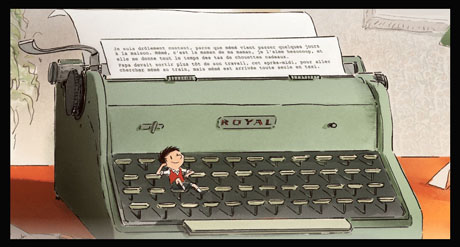
Amandine Fredon: It’s exactly that. Anne Goscinny and our producers are behind this project. We really liked the idea of showing behind the scenes, how characters and a universe are created… getting into the heads of these two authors. Their work is a mixture of invention and reality. They are inspired by their life but transform it to create Little Nicholas a dream childhood that they never had. They live this ideal childhood through their Little Nicholas.
JM: This is a film about the collaborative process. What does the collaborative process mean to you?
BM: It’s actually really funny, Amandine comes from an art school and I come from an editing and screenwriting background, so you can say that she was my Sempé and I was her Goscinny. We were very complimentary from the beginning and as the movie evolved our everyday interactions and the way we worked together really infused into the story. I was curious at first but we ended up putting a lot of ourselves and our relationship into the characters and in a bizarre way they started mimicking us and we started mimicking them. Was it life imitating art or art imitating life? We got confused at some point.
AF: The most important thing is to have the same point of view of the film, the same direction. Benjamin is very good at building the narrative through editing, and for my part, I did a lot of artistic tests with the teams. The project was difficult, both to have a fluid narration between the two worlds, and at the same time to adapt Sempé’s drawing style. So we had to work together. It was very motivating and exciting.

JM: Rene and Jean-Jacques get their inspiration from their lives and what they observe in public places. Where do you get your inspiration from?
BM: I’d love to say that I’m some kind of a poet and that inspiration comes to me wandering the streets of Paris but to be honest it doesn’t. Most of my inspiration comes from hard work. In the case of the movie, we did memoir-like research, almost PhD level stuff, on the lives of Sempé and Goscinny. And through that work came the story that we’re telling today. A story of resilience, of two men that were robbed of their childhood and created that perfect childhood for Nicholas so they could live through him things they couldn’t as children themselves.
AF: Indeed, with Benjamin we looked at all the documentation that exists on the authors but also on their work. And since they have worked all their lives, we had to spend a lot of time to see everything! Besides, we learned a lot about these two great authors. René Goscinny spent his childhood in Argentina, and Jean Jacques Sempé dreamed of becoming a musician. Luckily for us, he wasn’t very good at the piano, so he started drawing. And to give you an idea, René Goscinny wrote 222 stories of Little Nicholas! so we had plenty to do in terms of inspiration.
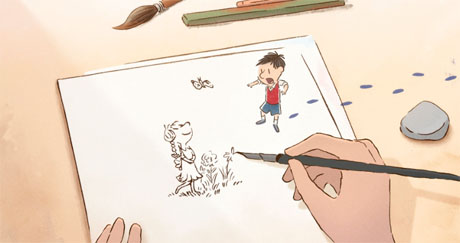
JM: How did you want to showcase the joy, humor and enthusiasm of children?
BM: First Amandine and I insisted on working with child actors to play the parts of Nicholas and his friends. Most of the time in France we use adult actresses that change their voice to play kids and for us it was impossible for this movie. Working with children was the only way we could make the audience relate to the joy and humor of the kids in the stories we’re telling. Then the poetry and comedy of those childish stories also comes from the unique style of Jean Jacques Sempé that we’re paying tribute to in the movie.
AF: The theme of childhood is important for both authors and their talent is to mix gag and poetry. It was therefore necessary to find a good balance between the two. Little Nicholas is not a model child. He does stupid things, has fun, laughs with his friends, is sometimes naive but always very endearing. In the film, unlike the adults, the children take advantage of the present moment.
JM: How important was it to present the relationship between Rene, Jean-Jacques and the Nicholas who comes to life and talks with them?
BM: From the beginning, our film, like most of Sempé’s and Goscinny’s work, was designed for all audiences. We wanted to make a movie that could work for kids and adults alike. Pretty quickly we thought that installing a dialogue between Nicholas, a kid, and his creators, adults, would be a great way to achieve that. We talked about difficult parts of Goscinny’s and Sempé’s life during the course of our story but as they tell their story to Nicholas, at a kid’s level, it makes it easier for the young audiences to understand as the memories are seen through the eyes of a child. It allowed us not to be too grim and still stay true to René’s and Jean-Jacques’s story. That really helped us to talk to children about really hard subjects like the Holocaust or Jean-Jacques’s abusive stepfather.
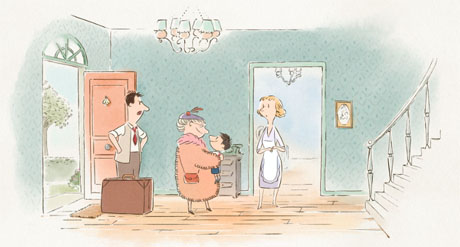
AF: We wanted to do the whole film in animation from the point of view of a child. This allows us to have an active little Nicholas, who asks questions, challenges the spectators, and discusses with these creators. Children can easily identify with him. In the stories written by René Goscinny, the links between the characters are the most important. Bonds between children, parents, grandparents, friends… So having the active Little Nicholas who questions these authors makes it possible to identify with him and to create strong connections with the characters and also the spectators. It appears on their desktop as a mental image, as if it were in the minds of the authors.
JM: Why do you think generations of people love comics / comic strips / newspaper and magazine artwork and stories?
BM: I think it has a lot to do with keeping a part of our childhoods with us. The stories we were read by our parents, the ones we discovered, ourselves, growing up that are part of the adults we are today. In the case of “Little Nicholas” I think it has a lot to do with the fact that the stories written by Goscinny are in first person. Nicholas is narrating these books, and they are still very funny. Although life is very different for kids growing up in the world today, they still have similar experiences with their families, their friends at schools and teachers. The comedy and poetry are still relevant today. Sempé drawings also have become a classic representation of the post war era in France. That France that kind of stuck in the minds of people around the world: with the sound of jazz floating in the streets and artists crowding the cafés of Saint Germain des Près. Mixed with a zest of comedy and poetry coming from a 10 year old’s look on life, thanks to Goscinny’s writing, it makes that piece of French culture very universal, and I think discovering the Little Nicholas today is even more touching then it was in the 50’s. And it might be even cooler abroad than it is in France.
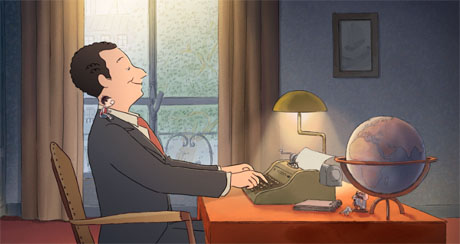
AF: The imaginary side, dreamed, which takes us out of the ordinary, a world where everything is possible. Drawings also make it possible to create very personal universes and this is the case for the work of Jean Jaques Sempé. He always used ink and watercolor, so we set out to reproduce his style with Toon Boom Harmony by computer but like classic 2D animation. When we see his drawings, we have the impression that it is very simple but when we try to imitate them, we realize the difficulty of the task. His line is extremely pure, stylized and he draws only the essential. Magazine artwork and comics allow us to escape from everyday life by making us laugh or dream. Like movies, they created many emotions.
JM: What were the movies you loved going to the cinema to see when you were children?
BM: It’s funny, because I don’t draw myself. I come from a screenwriting and editing background. But I grew up in a town near the center of France and lived close to a city called Clermont-Ferrand, which is famous for its short film festival. When I was in high school, I used to see a lot of animated short films at the festival and I was inspired by their creativity. They really opened my eyes to the possibility of the medium. In the late ‘90s, I saw Toy Story and The Nightmare Before Christmas, and then we had the Miyazaki movies and the Aardman shorts and movies — movies that had a huge impact on me.
AF: I too was fascinated by Aardman’s films in stop motion. It was moreover the films of Wallace and Gromit that made me want to go from drawing to animation. Japanese animation marked our childhood and Miyazaki’s films remain a reference for us. Films by Charlie Chaplin, Buster Keaton but also Tex Avery that I watched on Sunday evenings with my family marked me a lot with their creativity.
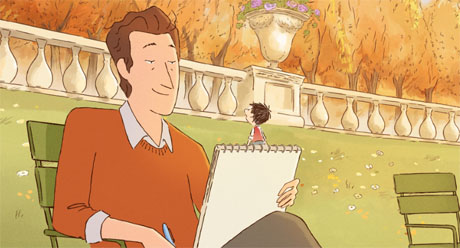
JM: Little Nicholas is qualified for the Academy Awards and the Annie Awards. How do you feel about the positive reception the film has received, including the Annecy win?
BM: It’s been an incredible ride. We thought we were making a family movie, really for mainstream audiences and we ended up having an amazing reception by critics and in festival.s We were the only animated movie selected in Cannes this year, and winning the Crystal in Annecy was mind blowing. It’s an honor for us just to be qualified for the Oscars and the Annies. It’s crazy to think that we have a small chance to be nominated among all the great studios and directors making the best of animation worldwide.
AF: It was an incredible adventure to make this film with Benjamin and all the very talented teams. It was very emotional and amazing for us to adapt René Goscinny and Jean Jacques Sempé’s work for the cinema. All the creative teams were passionate about the work of the two authors and they gave a lot for the film. The atmosphere was incredible, and I think we can see it in the film. The Cannes and Annecy festivals, the many prizes, the reception of the spectators… After so much work, we appreciate the good reception for the film — and managing to move so many audiences of all generations and all different nationalities is the best reward.
- INTERVIEW: Strap In For “Mars Express” - April 30, 2024
- INTERVIEW: Jeff Fowler On “Knuckles” And “Sonic 3” - April 22, 2024
- INTERVIEW: “Inside Out 2” Director And Producer On Pixar Sequel - April 16, 2024


 December 30th, 2022
December 30th, 2022  Jackson Murphy
Jackson Murphy  Posted in
Posted in  Tags:
Tags: 






